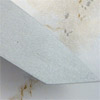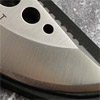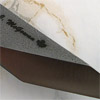Chisel Grind - Blade Geometry
Chisel Grind Info

Description
A chisel grind is called that simply because it resembles a chisel. The Chisel grind is only ground on one side, and thus has a asymmetrical cross-section as you can see from the diagram. The other side of the blade is totally flat.
One misconception of the chisel grind is that it is stronger than a normal V grind, when in actuality, it is weaker, because the angle is more acute. For Example, if a knife is ground at 15° on one side only, it makes the total edge angle at 15°. However, when you grind both sides at 15°, you have a total edge angle of 30°, which is substantially stronger. Having said that, chisel ground knives are usually ground at a slightly more obtuse angle on the one side, but usually the total angle is still less.
One benefit of having the chisel grind is the very thin edge that can be obtained, along with ease of production as only one side needs to be ground. However, it is extremely difficult to cut straight with a chisel ground knife as the knife has a tendancy to veer off to one side due to the asymmetrical grind.
The Chisel grind is not that commonly seen anymore in sporting knives, but enjoyed a brief period of popularity in the late 90's on tactical knives. Ernest Emerson uses it in his popular CQC-7, and it is also commonly found on Japanese kitchen knives used for slicing fish as well as Kiridashis, which are wood carving knives.


